NUMARK NS6 II
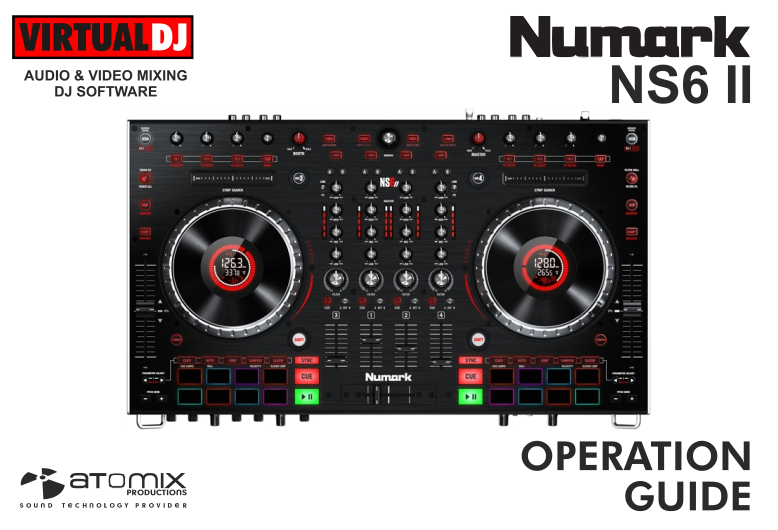
SETUP
Firmware & Drivers
Firmware: Please update NS6II firmware to the latest version by visiting Numark website
Drivers: Windows users install the latest drivers from Numark.
MAC OS X users don't need to install any drivers.
(in case you have not done already)
Once VirtualDJ 8 is launched, a Login Window will appear. Login with your virtualdj.com account credentials. A Pro Infinity or a Pro Subscription License is required to fully use the Numark NS6II
Without any of the above Licenses, the controller will operate for 10 minutes each time you restart VirtualDJ.
Buy a license

Click on the "Use Soundcard" button in order VirtualDJ to apply the pre-defined audio configuration (speakers need to be connected to the rear side of the unit in this case).
Click on the Change skin button in order the 4 Decks default skin of VirtualDJ to be loaded.
Click to OK

Advanced Setup
The unit should be visible in the CONTROLLERS tab of Config and the “factory default” available/selected from the Mappings drop-down list. The factory default Mapping offers the functions described in this Manual, however those can be adjusted to your needs via VDJ Script actions.
Find more details at
VDJ Pedia
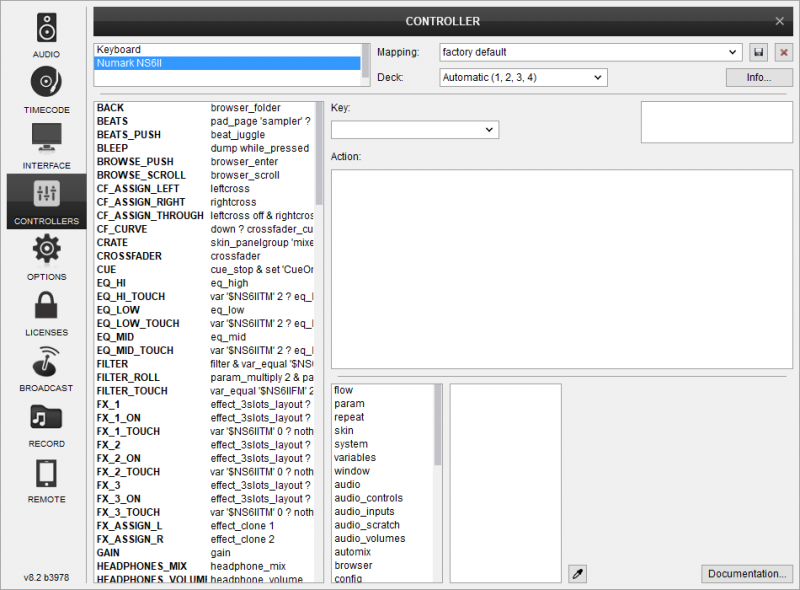
AUDIO Setup
The unit has a pre-defined Audio setup and a special button in the AUDIO tab of Config to provide that. Alternative Audio setups can be applied in the same window.

For further software settings please refer to the Manuals of VirtualDJ 8.
LAYOUT

S SHIFT Press and hold this button to access secondary functions (in red lettering) of other controls on the NS6II.
The functionality of each button and knob per section (as shown in the image above) will be explained in detail in the next chapters:
A. Mixer Controls
B. Deck Controls
C. Pads
D. Browser Controls
E. Effect Controls
F. Front & Rear Sides
Front - Rear

- MIC 1 EQ: Adjust the equalizer for mic 1 audio input.
(Hardware operation, not visible inside VirtualDJ GUI) - MIC 2 EQ: Adjust the equalizer for mic 2 audio input.
(Hardware operation, not visible inside VirtualDJ GUI) - CROSSFADER CURVE ADJUST: Adjusts the curve of the crossfader
- HEADPHONES MIXING: Adjust how the Channels and the Master Output blend at the Headphones Channel.
- HEADPHONES SPLIT: Split the audio on your headphones so that Headphones Channel comes out of left speaker, and Master Channel from the right.
- HEADPHONES VOLUME: Adjust the volume of the Headphones Channel
- HEADPHONES CONNECTOR: Connect your headphones. Both sizes (3.5mm and 6.35mm ( 1⁄4 in)) are offered.
- POWER SWITCH: Turns on/off the power on the device. Please turn on the device only after doing and securing all connections on the back.
- DC INPUT: Connect the supplied PSU
- USB 2 CONNECTOR: Use a standard USB cable to connect NS6II with your computer.
- USB 1 CONNECTOR: Use a standard USB cable to connect NS6II with your computer.
- LINE/PHONO SW 4: Switches input 4 between line and phono signal levels.
- INPUT 4: Connect an analog device that will be routed on channel 4 of NS6II mixer.
- INPUT 3: Connect an analog device that will be routed on channel 3 of NS6II mixer.
- LINE/PHONO SW 3: Switches input 3 between line and phono signal levels.
- MIC 2 INPUT: Connect a mic on the NS6II mixer. You can use only a Jack (TRS) connector. Please note that MIC inputs are hardware controlled.
- MIC 1 INPUT: Connect a mic on the NS6II mixer. You can use only a Jack (TRS) connector. Please note that MIC inputs are hardware controlled.
- BOOTH OUT: Booth signal output (RCA – Unbalanced). The strength of the output signal is controlled by “BOOTH VOLUME” knob (14) on the mixer section. Use it to connect your booth speakers, or an amp that needs different sound output level than master output.
- MASTER OUT 2: Master signal output connectors (RCA – Unbalanced). Use it to connect with another mixer, or consumer grade amplifier.
- MASTER OUT 1: Master signal output connectors (XLR – Balanced). Use this to connect on your pro grade amplifier or self-powered speakers.
MIXER
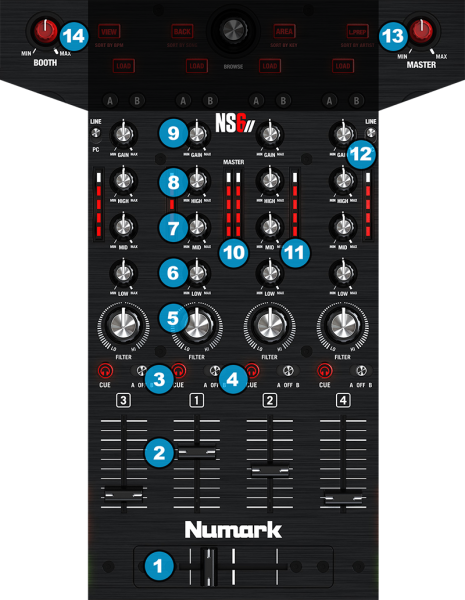
- CROSSFADER: Blends audio between the channels assigned to the left and right side of the crossfader.
- VOLUME: Volume Faders (mixer channel order is 3-1-2-4 decks). A different mixer channel order can be selected from VirtualDJ Settings
- PFL: Press these buttons to send this channel's pre-fader signal to the Cue Channel for monitoring. When engaged, the button will be lit. By pressing one PFL button at a time, you will cue that channel alone (and deactivate PFL monitoring for the other channels). To cue to multiple channels simultaneously, press the PFL buttons for those channels at the same time.
- CROSSFADER ASSIGN: Routes the audio playing on the corresponding channel to either side of the crossfader (A or B), or bypasses the crossfader and sends the audio directly to the Program Mix (center, OFF).
- FILTER: Applies a resonance Filter on the software decks. Depending on the FILTER MODE (21) the Filter knob also offers 2 additional functions.
On FILTER ROLL mode, the knob applies a Loop Roll effect as well. The size of the loop roll starts from 1/2 beat and ends to 1/16 beat (left or right end position)
On FILTER FX Mode the knob also controls the 1st parameter of the selected effect. On zero position the effect slider gets value 0%, and at the right/left end positions the parameter gets value 100%. - EQ LOW: Adjusts the low (bass) frequencies of each mixer channel/deck. When Touch EQ Mode is activated, touching the knob will mute the corresponding channel's low frequencies (aka "EQ kill").*
- EQ MID: Adjusts the middle (mid) frequencies of each mixer channel/deck. When Touch EQ Mode is activated, touching the knob will mute the corresponding channel's mid frequencies (aka "EQ kill").*
- EQ TREBLE: Adjusts the high (treble) frequencies of each mixer channel/deck. When Touch EQ Mode is activated, touching the knob will mute the corresponding channel's high frequencies (aka "EQ kill").*
*Note: The used/killed frequencies depend on the selected EQ mode. Set the equalizerMode setting to Kill mode (from Conifg OPTIONS tab) if you wish to get a complete cut of sound when knobs are at 0% or touched on EQ Kill mode. - GAIN: Adjusts the audio level (gain) of the corresponding channel in the software or hardware Input. When Touch EQ Mode is activated, touching the knob will mute the sound of the corresponding mixer channel/deck (MUTE text will be visible on the Track’s Title/Artist on the GUI)
- MASTER VU-METER: Shows the strength of the master output audio signal.
- CH VU-METER: Shows the pre-fader strength of the channel's audio signal. When the WHITE led is lit, the corresponding channel limiter is engaged to prevent distortion of the audio signal.
- PC/LINE: Switch decks 3 & 4 between hardware operation (analog audio sources connected on the back of the unit) and PC operation. When a channel is set to hardware mode, the corresponding software deck will be muted.
- MASTER VOLUME: Adjusts the Master Output Volume
(Hardware operation. Movement will not be visible on the VirtualDJ GUI) - BOOTH VOLUME: Adjusts the Booth Output Volume
(Hardware operation. Movement will not be visible on the VirtualDJ GUI)
DECK CONTROLS
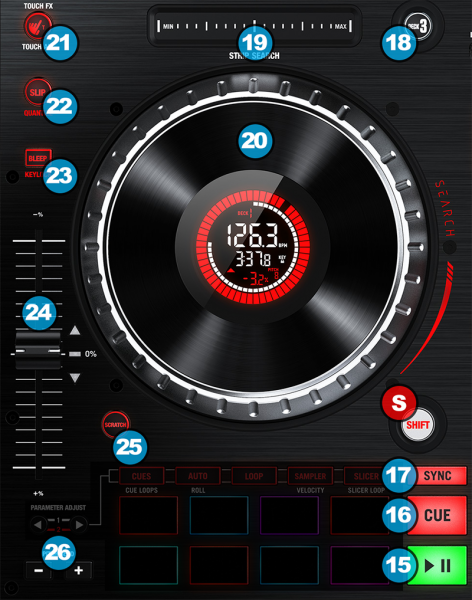
- PLAY: Plays / Pauses the track.
Press and hold SHIFT and then press this button to "stutter-play" the track from the last set Cue Point. - CUE: When the Deck is paused, you can set a temporary Cue Point by moving the Platter to place the Audio Pointer at the desired location and then pressing the Cue Button.
During playback, you can press the Cue Button to return the track to this Cue Point. (If you did not set a Cue Point, then it will return to the beginning of the track.).
If the Deck is paused, you can press and hold the Cue Button to play the track from the Temporary Cue Point. Releasing the Cue Button will return the track to the temporary Cue Point and pause it.
To continue playback without returning to the Temporary Cue Point, press and hold the Cue Button, then press and hold the Play Button, and then release both buttons.
Press and hold SHIFT and then press this button to return to the beginning of the track. - SYNC: Press this button to automatically match the corresponding Deck's tempo and phase with the opposite Deck's (or the Master Deck’s if using a 4 decks Skin) tempo and phase.
Hold SHIFT down and then press this button to set this deck as Master Deck (for 4 decks skins). - DECK SWITCH: Press this button to toggle control between decks 1&3 for the left side or 2&4 for the right side
- STRIP SEARCH: The length of this strip represents the length of the entire track. Place your finger on a point along this sensor to jump to that point in the track (song position). While your finger touches the strip, the track will start a temporary playback (if it was not playing before) in order to preview that area of the track. Lift your finger from the strip to stop playback.
Important notice: In order to avoid accidental track jumps when you manipulate FX, the needle search does not operate when the deck is on air. If you want to use the strip while a deck is on air please hold down SHIFT first, and then touch the strip. - JOG: Touch sensitive jogwheel. Use the jogwheel to scratch (if Vinyl mode is selected) or pitch bend.
Hold SHIFT down and then use the Jogwheel to fast search through the track, but keep the phase synced.
The Jogwheel also offers Loop In and Loop Out point adjustment (see Manual Loop Pads mode) - TOUCH EQ/FX (Left side):
Press this button once to enable the FX TOUCH Mode. On this Mode the Touch Capacitors of the FX knobs trigger the Effects while touched.
Press this button a second time to enable the EQ/FX TOUCH Mode. Led will blink to indicate this mode. On this Mode, the Touch Capacitors of the FX knobs trigger the Effects while touched (same as FX TOUCH Mode), and additionally the EQ Touch Capacitors will kill the corresponding frequencies while touched.
Press this button a third time to turn off FX TOUCH Mode.
- FILTER MODE (Right side):
Press this button once to enable the FILTER ROLL Mode (LED lights on). On this mode, operating the filter knob will also engage a variable length loop roll effect.
Press this button a second time to enable the FILTER FX Mode (LED Flashes). On this mode, operating the filter knob will also trigger the effect of the first Effect Slot.
Press this button a third time to turn off FILTER FX Mode. - SLIP: Press this button to activate the Slip mode. Several software functions (such as Jogwheel movements, HotCues and Loops) will apply temporary on the track, and the track will return to the position it would have been when as if those functions were not triggered.
Hold SHIFT and press this button to toggle Quantize on/off. When Quantize is enabled, several features as setting hotcues, jumping between hotcues, setting loops e.t.c. will be quantized on the CBG of the track. - BLEEP: While this button is held, the playback of the track will be reversed. When released the track will resume normal playback from where it would have been if you had never engaged the Bleep function (i.e., as if the track had been playing forward the whole time).
Hold SHIFT and press this button to toggle Key Lock on/off. When Key Lock is activated the tracks key will "lock" at the current value. The track's tempo will remain at the speed designated by the Pitch Fader. - PITCH: Adjust the track's playback speed (tempo). The white LED next to the fader will light up when the unit’s fader is set at 0%. The Red Up and Down Arrow LEDs will lit if the pitch position of the unit and the actual pitch of the software do not match, to indicate the direction you need to move the hardware fader in order to catch the software one.
- SCRATCH: Press this button to set the Jogwheel to Vinyl (Scratch) or CD (Bend) mode. When Vinyl mode is active, you can still use the outer part of the Jogwheel to bend (temporary speed up – slow down the tempo of the track).
Hold SHIFT and press this button to switch Time Display (30) between Elapsed and Remain modes. - PITCH BEND: Press and hold down to temporary speed up/slow down the song while pressed. When released, the track playback will return to the speed designated by the Pitch Fader
On Jog Display
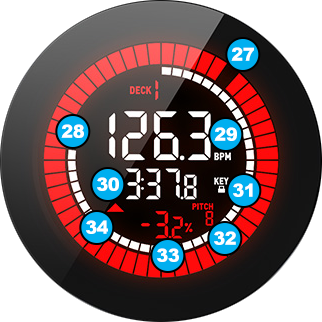
- RED RING - VINYL ROTATION: Indicates the position of the software jogwheel - shows rotation.
You can switch rotation behavior from VirtualDJ Settings RPM between 33 RPM, 45RPM and 4 Beats Per Round. - WHITE RING - TRACK PROGRESS: Indicates the track's position in time, starting with an empty circle and ending to a full circle when track reaches its end. The white circle will start blink when track reaches 30 seconds before end.
- BPM: Displays the current BPM value of the track.
- TIME: Displays the Remain (with a minus mark) or the Elapsed Time of the track. Time mode can be selected by pressing SHIFT+SCRATCH (25)
- KEY LOCK: Will be displayed when the Key-Lock is enabled on the deck.
- PITCH RANGE: Displays the current pitch range used by the pitch slider
- PITCH: Displays the current pitch adjustment of the track
- PITCH ARROWS: The arrows will turn on if the actual position of the Pitch Fader and the software Pitch value don't match and they will indicate the direction the hardware Pitch Fader needs to be moved to, in order to catch the software value.
This may happen if the SYNC button is used, or if ResetPitchOnLoad option is enabled.
Pads
PADS (35) offer 10 different modes, depending on the PAD MODE selection buttons (36).
Press a PAD MODE button once to select a mode (the LED of the mode will turn on). Press the same PAD MODE button again to access the additional mode (the LED will blink as an indication).
Each time a mode is selected, a Page will be selected and displayed on the Pads section of the default VirtualDJ skins
Use the PARAMETER buttons (37) to adjust the Parameter 1 (if available) of the selected Pads page
Hold SHIFT down and then use the PARAMETER buttons (37) to adjust the Parameter 2 (if available) of the selected Pads page
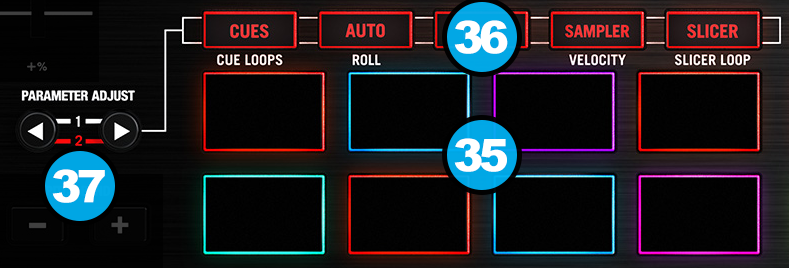
HotCues mode
Press the CUES mode button to set the PADs to HotCue mode. The Hotues page will be then selected and displayed on the Pads section of the VirtualDJ skin
Each one of the 8 pads assigns a Hot Cue Point (1 to 8) or returns the track to that Hot Cue Point.
When a Hot Cue Button is unlit, you can assign a Hot Cue Point by pressing it at the desired point in your track. Once it is assigned, the Hot Cue Button will light up.
Hold SHIFT and then press any of the pads to delete its assigned Hot Cue Point.
Use the PARAMETER and buttons (37) to jump to the next or previous HotCue.
Hold SHIFT down and then use the PARAMETER buttons to jump the track forward/backwards by 1 beat
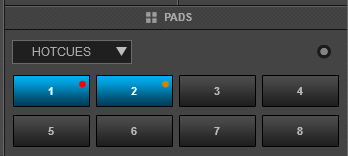
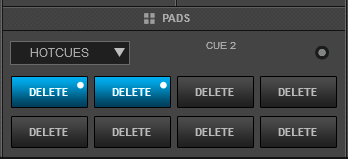
Note: By default Hotcues will get the color of the deck (blue for deck 1, red for deck 2, green for deck 3 and orange for deck 4). A different coloring behavior can be offered via the NonColoredPOI setting (from VirtualDJ Settings OPTIONS tab).
Cue-Loop mode
Press the CUES Mode button twice (or once if the selected mode was HotCues) to set the Pads to HotCue Loop mode (the led of the CUES button will blink). The CueLoop page will be then displayed on the Pads section of VirtualDJ skin
Each one of the 8 Pads assigns a Hot Cue Point or returns the track to that Hot Cue Point, but in both cases, it also triggers a momentary or toggle Loop depending on the selected mode.
The currently selected length will be used for the triggered Loop
Hold SHIFT down and then press a pad to jump to the Hot Cue Point but leave the Loop enabled.
Use the PARAMETER and buttons (37) to half and double the size of the applied Loop.
Hold SHIFT down and then use the PARAMETER buttons to select the On/Off (toggle) or Hold (loop will be enabled while the Pad is pressed) mode
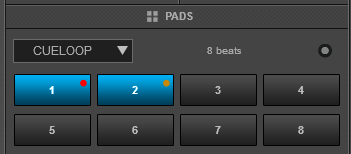
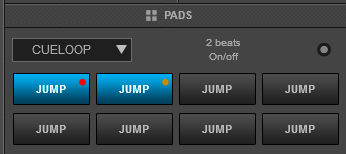
Auto Loop mode
Press the AUTO mode button to set the Pads to Auto Loop mode. The LOOP page will be then selected and displayed in the Pads section of the default VirtualDJ skins.
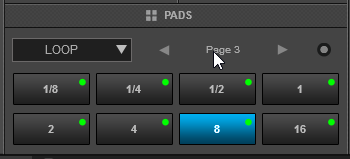
In this mode, each one of the 8 Pads triggers an Auto-Loop of a different size in beats, depending on the selected bank/page from 1/32 to 128 beats
Use the PARAMETER and (37) buttons to select a different bank/page with the desired loop sizes.
Hold SHIFT down and then use the PARAMETER buttons to select a trigger mode for the Loops (On/Off, Hold or Roll)
Loop Roll mode
While the Auto Loop mode is selected, press the same AUTO mode button again to set the PADs to Loop Roll mode (led will blink). The Loop Roll page will be then selected and displayed in the Pads section of the default skin of VirtualDJ
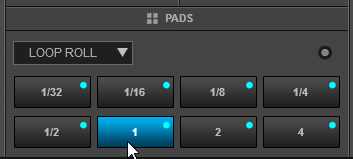

Each one of the 8 Pad triggers a momentary Loop Roll (while pressed) of a different length in beats as per the images above.
In this mode the PARAMETER (37) buttons have no functionality.
Manual Loop mode
Press the LOOP mode button to set the Pads to Manual Loop mode. The Manual Loop page will be then selected and displayed in the Pads section of the VirtualDJ default skin.

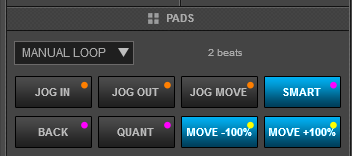
Each one of the 8 pad offers a different loop function.
Use Pads 1 and 2 to set a Loop Entry (In) and a Loop Exit (Out) point for manual looping.
Use Pad 3 to turn off the Loop (if enabled) or trigger a Loop of the selected size in beats
Use Pad 4 to repeat the last triggered loop (reloop)
Use Pads 5 and 6 to half/double the size of the Loop.
Use Pads 7 and 8 to move the Loop (if enabled) forward/backwards by 1 beat
While SHIFT is pressed use ..
Pad 1 to set the Jogwheel to Loop In Adjust mode and use the Jogwheel to fine adjust the Loop In position
Pad 2 to set the Jogwheel to Loop Out Adjust mode and use the Jogwheel to fine adjust the Loop Out position
Pad 3 to set the Jogwheel to Loop Move Adjust mode and use the Jogwheel to fine move the Loop through the track.
Pad 4 to enable/disable Smart Loop. When Smart Loop is enabled (default status), using Loop In and Loop Out buttons to trigger a Manual Loop, will result of a seamless loop (track will stay on beat)
Pad 5 to enable/disable Loop Back mode. When Loop Back mode is enabled, and an Auto Loop is enabled, the current track's position will be considered as the Loop Out (Exit) point of the loop and the passed part of the track will be looped.
Pad 6 to enable/disable Quantize Loop mode. When enabled, the Loop In point of a Loop will be snapped to the nearest beat
Pad 7 and 8 to move the loop (if enabled) forward/backwards by the amount of the size of the loop.
Use the PARAMETER and (37) buttons to halve/double the size of the Loop
Saved Loops mode
Press the LOOP Mode button twice (or once if the selected mode was Manual Loop) to set the Pads to Saved Loops mode (the led of the LOOP button will blink). The Saved Loops page will be then selected and displayed in the Pads section of the VirtualDJ skins.
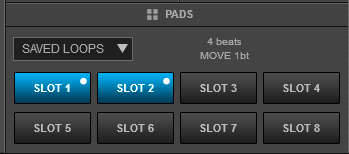
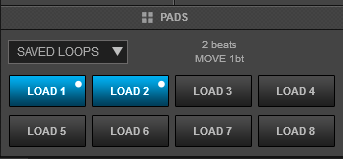
This mode offers the ability to save up to 8 Loops to individual Loop Slots.
Press any Pad to save the current Loop at the current track’s position (of the selected size in beats) to the relative slot. Hold the same Pad down for more than 1 second to delete the Saved Loop.
When a Loop slot is saved, press the corresponding Pad to load (prepare) the Saved Loop.
If the track’s position is before the Saved Loop point, the loop will be enabled but the track will not jump to that position (Prepare status). Use the same Pad to disable the Loop.
Hold SHIFT down and then press one of the lower Pads to load the Saved Loop, but also jump to that position.
Use the PARAMETER and (37) buttons to halve and double the size of the triggered Loop.
Hold SHIFT down and then use the PARAMETER buttons to move the Loop forward/backwards by 1 beat
Sampler mode
Press the SAMPLER mode button to set the PADs to Sampler mode. The Sampler Page will be then selected and displayed in the Pads section of the VirtualDJ default skins
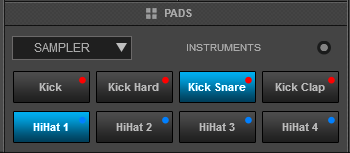
Each one of the 8 pads triggers a sample (1 to 8) from the selected Sampler Bank of VirtualDJ.
The leds of the Pads will automatically get the assigned color of each sample (dark when off, bright when playing).
Press the pads to trigger a sample. Depending on the selected trigger mode, use SHIFT and the same pads to stop the sample.
Use the PARAMETER and buttons (37) to select the previous and next Sampler Bank.
Hold SHIFT down and then use the same PARAMETERS buttons to select the previous/next Trigger Pad mode (on/off, hold, stutter, and unmute)
Hold SHIFT down and then press the SAMPLER mode button to start/stop recording the deck to a new Sample (led will blink fast while recording).
Sampler Velocity mode
While the Sampler mode is selected, press and hold down the same SAMPLER mode button for more than 1 second to to enable/disable Sampler Velocity mode (led will blink fast).
When enabled, each one of the 8 pads triggers a sample (1 to 8) from the selected Sampler Bank of VirtualDJ, with the difference that the Output Volume of each sample is determined by the strength the Pad was initially pressed.
Tip: To return all samples to their maximum values after the Velocity mode is used, select the next or previous available bank and then select the current again.
Key - HotCue mode
While the Sampler mode is selected, press the SAMPLER mode button again to set the PADs to Key - Hotcue mode (led will blink). The KeyCue Page will be then selected and displayed in the Pads section of the VirtualDJ default skins
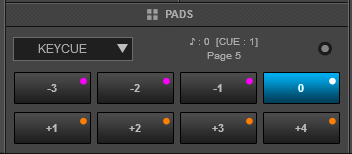
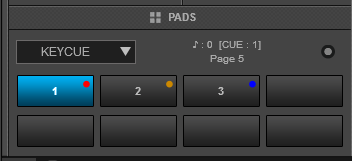
In this mode, the Pads trigger a selected Hotcue point (or the Temporary Cue if none selected or not available) at a selected Key semitone (from -7 to +7).
8 different pages/banks are offered with various semitone values to use and a 0 value (reset key to tis original value) is always offered in all pages.
Hold SHIFT and then select a Hotcue for the Key pads to trigger. Each time a Pad is pressed, the track will jump to that Hotcue point and will also alter the Key of the track to the value designated by it assigned value.
Use PARAMETER and buttons (37) to adjust the Key of the track without triggering a Hotcue.
Hold SHIFT and then use the PARAMETER buttons to select a different page/bank with different key semitone values.
Slicer mode
Press the SLICER mode button to set the PADs to Slicer mode.The Slicer Page will be then selected and displayed in the Pads section of VirtualDJ skin.
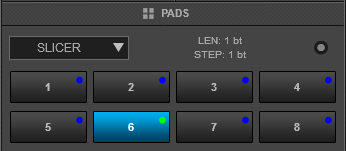
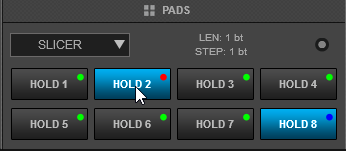
The eight pads represent eight sequential beats/Slices in the Beat Grid. The playing Slice is represented by the currently green lit pad. The green light will "move through the pads" as it progresses through each eight-Slice phrase. Press a pad to repeat that Slice (hold it down if you want to keep looping it). Once the Pad is released the track will continue to play from the position it would have been if the pad was never pressed.
Hold SHIFT button down and then use the same Pads to use the Slicer in Hold mode. In this mode, the slices are memorized (using the last triggered ones)
Use the PARAMETER and buttons (37) to adjust the length of the Loop applied to the slice. Press SHIFT and then use the same PARAMETERS buttons to adjust the step of the Slices.
Beatjump mode
While the Slicer mode is selected, press the same SLICER mode button again to set the PADs to Beat Jump mode (led will blink). The BeatJump page will be then selected and displayed on the Pads section of the VirtualDJ skin
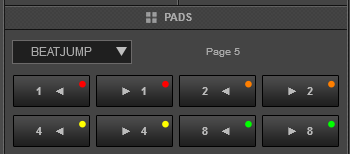
In this mode, each one of the Pads will jump the track backwards/forward by the amount of beats depending on the selected page/bank (from 1/8 beats to 32 bars)
Use the PARAMETER and buttons (37) to select a different bank/page with the desired size of beat jumps
Browser

- VIEW: Changes Sideview window of the browser between Sidelist, Automix/Playlist, Sampler and Clone views.
Hold down SHIFT and press this button to sort the browser by the BPM column. If the browser is already sorted by BPM it will toggle between ascending and descending sort orders. - BACK: Changes focus to Folders window of the browser, and opens/closes subfolders.
Hold down SHIFT and press this button to sort the browser by the TITLE column. If the browser is already sorted by TITLE it will toggle between ascending and descending sort orders. - AREA: Switches the central panel on default VirtualDJ skins between Mixer, Video, Scratch & Master
Hold down SHIFT and press this button to sort the browser by the KEY column. If the browser is already sorted by KEY, then it will toggle between ascending and descending sort orders. - LOAD PREPARE: Adds the selected track(s) on the main browser window on the current playlist.
Hold down SHIFT and press this button to sort the browser by the ARTIST column. If the browser is already sorted by ARTIST it will toggle between ascending and descending sort orders. - BROWSE ENCODER: Scrolls through Folders or Files. Push the encoder down while focus is on Folders window, to return to the songs window. Push the encoder down while on Songs or Sideview windows to load the selected track on the first available deck.
Hold down SHIFT and turn the encoder to scroll 5 songs at a time. - LOAD: Loads the selected track on the corresponding deck.
EFFECTS
Both Effect units (on the left and right side of NS6II) offer 2 different operation modes and they control the Effects applied on the corresponding left or right deck.
Hold SHIFT down and then press the TAP (50) button to toggle between the Single FX and Multi FX operation mode.
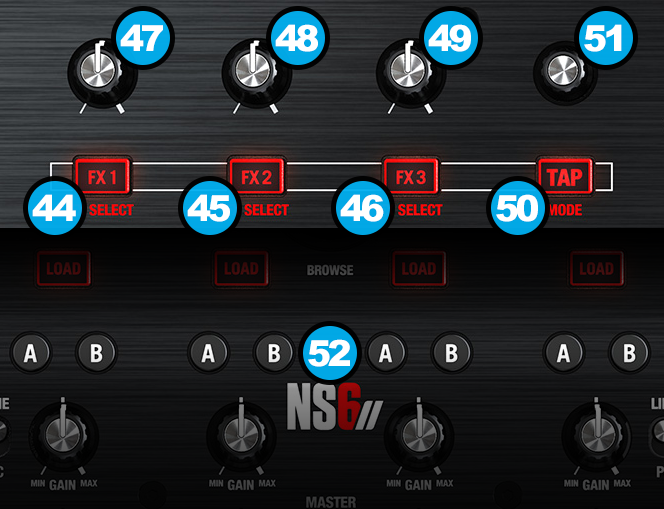
SINGLE FX MODE
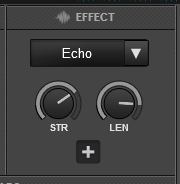

In this mode a single Effect is controlled with up to 6 Parameters and 3 Effect buttons. Only the first 2 Parameters are visible on the GUI. More Parameters and Effect buttons can be viewed in the FX GUI (opened from the + button on the GUI)
- FX1 ON: Enables/disables the selected effect.
Hold down SHIFT and press this button to enable/disable the 1st effect button of the selected effect (if available). - FX2 ON: Select the previous effect from the effects list.
Hold down SHIFT and press this button to enable/disable the 2nd effect button of the selected effect (if available). - FX3 ON: Select the next effect from the effects list.
Hold down SHIFT and press this button to enable/disable the 3rd effect button of the selected effect (if available). - FX1 knob: Controls the 1st effect parameter of the selected effect.
Hold down SHIFT and turn the knob to control the 4th effect parameter of the selected effect (if available). - FX2 knob: Controls the 2nd effect parameter of the selected effect (if available).
Hold down SHIFT and turn the knob to control the 5th effect parameter of the selected effect (if available). - FX3 knob: Controls the 3rd effect parameter of the selected effect (if available).
Hold down SHIFT and turn the knob to control the 6th effect parameter of the selected effect (if available).
When FX Touch Mode (21) is activated, touch the FX1 knob (47) to activate the current effect, and release the knob to deactivate it.
MULTI FX MODE
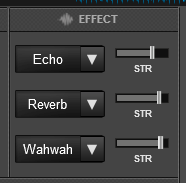

In this mode 3 different Effects can be applied and controlled with up to 2 Parameters for each FX slot. Only the first Parameter is visible on the GUI (and the 2nd Parameter while SHIFT button is held on the NS6II). More Parameters and Effect buttons can be viewed in the FX GUI (opened from the + button on the GUI
- FX1 ON: Enable/disable the selected effect of slot 1.
Hold down SHIFT and press this button to select the next available effect for slot 1. - FX2 ON: Enable/disable the selected effect of slot 2.
Hold down SHIFT and press this button to select the next available effect for slot 2. - FX3 ON: Enable/disable the selected effect of slot 3.
Hold down SHIFT and press this button to select the next available effect for slot 3. - FX1 knob: Controls the 1st effect parameter of the selected effect of slot 1.
Hold down SHIFT and turn the knob to control the 2nd effect parameter of the selected effect of slot 1 (if available). - FX2 knob: Controls the 1st effect parameter of the selected effect of slot 2.
Hold down SHIFT and turn the knob to control the 2nd effect parameter of the selected effect of slot 2 (if available). - FX3 knob: Controls the 1st effect parameter of the selected effect of slot 3.
Hold down SHIFT and turn the knob to control the 2nd effect parameter of the selected effect of slot 3 (if available).
When FX Touch Mode (21) is activated, touch any of the knobs to activate their assigned effect slot, and release the knobs to deactivate it.
OTHER FX KEYS
- TAP button: TAP this button to manually set the BPM of the track (in case the automatic detection algorithm failed to find the correct BPM value)
Hold SHIFT down and press this button to toggle between the Single FX and Multi FX modes (the corresponding panels on the Default GUI of VirtualDJ will follow the selection). - BEAT Encoder:Moves forward/backwards the track by 1 beat.
Press the encoder down to jump alternatively 1 beat forward and 1 beat backwards.
Hold SHIFT and turn this knob to adjust the Key of the loaded track.
Hold SHIFT and push the knob to reset the Key of the track to its original value.
If the selected pad page is set on Sampler then use this encoder to adjust the master volume of the Sampler.
- FX A/B: Clone the effects from one deck to the other. E.g if the FX A button on the channel 4 is pressed, the Effects from the left deck (A) will be cloned to the deck 2.
Advanced Audio Setup
Inputs
The Numark NS6II offers the ability to use 2 of it's channels as a stand-alone mixer.
Assign CH3 or CH4 Mixer Channels as external Source and route an Analogue Source (CD player, turntable etc) to the Master Output of the unit. Simply connect your analogue source to the rear side (Inputs) and set the PC/LINE Switcher of the corresponding mixer Channel to LINE.
Besides using CH3 and CH4 as a stand alone hardware mixer, Numark NS6II offers you the option to route the audio of it's analogue inputs inside VirtualDJ. Simply create the following audio setup by clicking on the "Line Inputs" button under VirtualDJ Audio setup window:
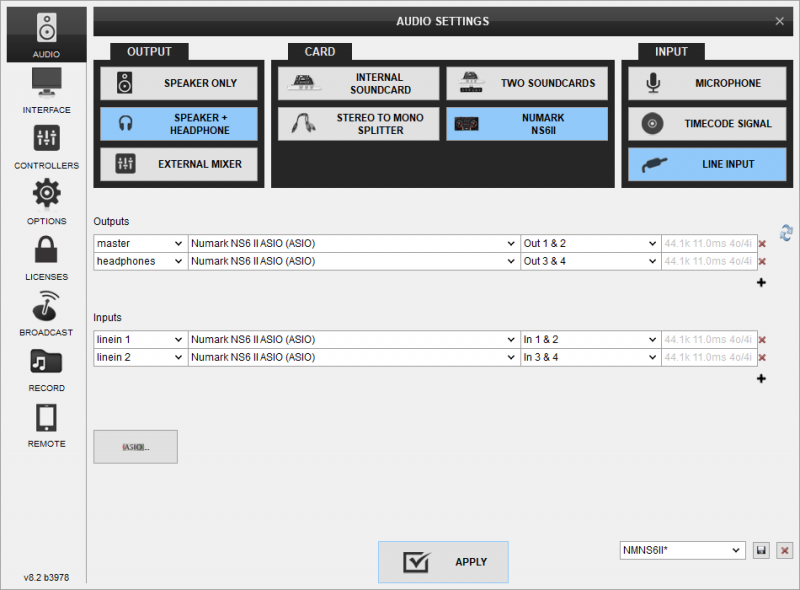
You can now use the line input options on VirtualDJ GUI to either play or record sounds from the analogue devices connected to the back of NS6II
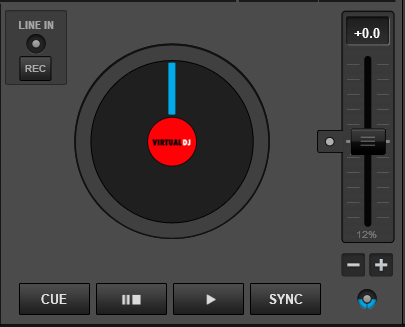
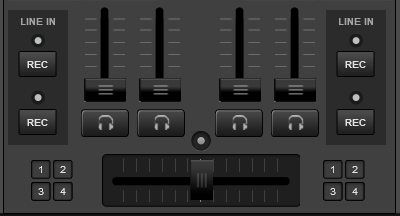
Timecode (DVS)
Numark NS6II offers the ability to control up to two software decks by using timecodes. Simply create the following audio setup by clicking on the "Timecode Signal" button under VirtualDJ Audio setup window:
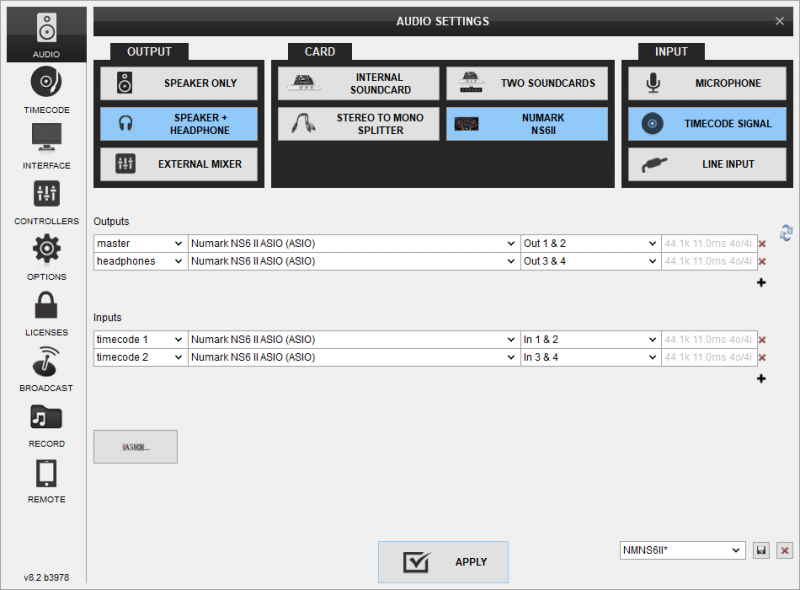
You can now use the timecode options on VirtualDJ GUI to enable/disable timecode control for the corresponding software deck.
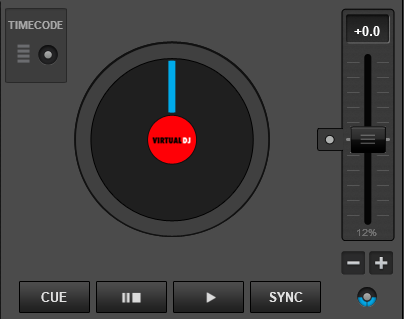
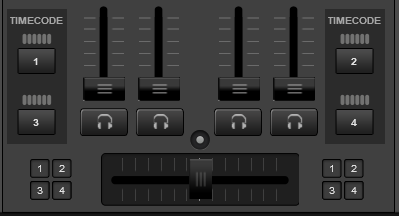
Recording
The pre-defined Audio configuration of VirtualDJ 8 for the Numark NS6II provides the ability to record your mix without any further adjustments.
However, if you wish to record both the software mix and the analogue inputs on the back of the device at the same time, you will need to route them through the software as described in the beginning of this chapter.
Due to hardware limitations it's impossible to record the audio of the MIC inputs connected on the back of NS6II as their audio is routed directly on the master output of NS6II. If you wish to record your mics or use the unit to broadcast you'll have to use a second/different audio interface.
